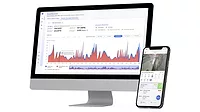7 top tips for buying the best video analytics software for your business

Video surveillance systems deliver tremendous security benefits to enterprise organizations. Among the benefits of today’s sophisticated cameras is the ability to detect changes in their field of view that might indicate a crime in progress. However, these same cameras also report a large number of false alarms that hinder a security team’s ability to concentrate on events truly requiring attention.
Is your organization struggling with false alarms? If so, consider artificial intelligence-based video analytics using machine learning technology to spot and virtually eliminate false alarms. But before selecting an advanced analytic software offering, ask yourself these seven questions.
1. Is the system scalable?
Is your organization growing? Will you be adding new sites soon? Answering Yes to either of these questions likely means you’ll be adding cameras. More cameras require an analytic solution that is easily scalable. Cloud-based software technology makes it quick and easy to expand the system at the click of a button and there’s no need for on-premises hardware. If you can get the technology on a monthly subscription basis paying per camera/per month, it’s easy to add or remove sites as business needs change.
2. Is the system easy to deploy?
You don’t want technicians scrambling about your site to install analytics. A plug-and-play system is easy to set up and results in less time spent on soak tests, troubleshooting and acceptance testing. The test phase is crucial when deploying analytics on an enterprise scale. Some security protocols require hardware and software to run for 30 days without errors before being accepted. If you’re looking for rapid deployment, a cloud-based system makes sense as there are fewer components to test.
Also, check to see if the analytic software is compatible with existing hardware, such as cameras, motion sensors, NVRs, and other current software, including monitoring station software and online dashboards.
3. An on-site or cloud-based solution?
We’ve already made a good case for choosing a cloud-based system, but that may not be the right choice for every organization. You may require on-site servers if detailed tracking of dwell time, line crossing or people counting is essential.
Analytics are installed in an on-site server, within cameras or in remote, cloud-based servers. If rapid installation and easy software updates is important, a cloud-based solution is the best choice.
4. How advanced are the analytics?
Companies make various claims about the capabilities of their AI technology. You’ll want to ensure you are getting a good return on your investment from a technology that is still relatively new. Ask about the solution’s neural network, the part of the software that adds intelligence. How long has the software been analyzing video? How accurate is it in filtering false alarms?
Google, Amazon and other providers create off-the-shelf neural networks. These ‘blank canvases’ require more time and resources to become accurate. It may take years to train them properly. Neural networks improve their accuracy with time and practice – in this case, by exposing them to millions of photos of people and vehicles. Look for a mature solution developed from scratch on a proprietary network
5. Will reducing false alarms improve security and employee morale?
Before you invest in analytic software, you want to know it will make a difference. When you’re looking at different software options, you should ask yourself another question:
- Can reducing false alarms from our employees’ workflow improve response time – either by in-house security or local law enforcement – to genuine alarms?
If the answer is Yes, then it’s highly likely that you’d benefit from intelligent video analytics. Reducing operators’ workload enables them to act faster on genuine alarms. Also, operators lose focus and motivation due to a relentless number of false alarms. Analytics are an excellent tool for improving productivity and morale.
6. Is the analytic system user-friendly and offer technical support?
Make sure your monitoring operators feel comfortable using the analytics and that training, if necessary, is readily available. With any technology, you’ll eventually need technical support. So, ensure the software provider you choose has a support team available in your time zone
7. Are free trials available?
Trying a product before buying it is the best way to make a final selection. Most video analytic companies offer free or reduced-price trials. Take advantage of the opportunity to make sure the software meets your organization’s needs. Before beginning a trial, set metrics with the sales rep and then see if the software meets your expectations. If so, you can purchase with confidence.
AI-based analytics enhance security and improve operator performance. Without the distraction of false alarms, operators pay more attention to genuine alarms, handle more events and improve overall response times.
By asking and answering these questions, you will likely find the best video analytic solution for your enterprise organization.
Looking for a reprint of this article?
From high-res PDFs to custom plaques, order your copy today!






